Back to Journals » Infection and Drug Resistance » Volume 13
Knowledge, Attitude, and Precautionary Measures Towards COVID-19 Among Medical Visitors at the University of Gondar Comprehensive Specialized Hospital Northwest Ethiopia
Authors Abate H , Mekonnen CK
Received 18 September 2020
Accepted for publication 11 November 2020
Published 2 December 2020 Volume 2020:13 Pages 4355—4366
DOI https://doi.org/10.2147/IDR.S282792
Checked for plagiarism Yes
Review by Single anonymous peer review
Peer reviewer comments 4
Editor who approved publication: Professor Suresh Antony
Hailemichael Abate, Chilot Kassa Mekonnen
Department of Medical Nursing, College of Health Science, Gondar, Ethiopia
Correspondence: Hailemichael Abate Email [email protected]
Background: Novel coronavirus disease 2019 (COVID-19) is an emerging respiratory disease caused by severe acute respiratory syndrome coronavirus. It was designated a public health emergency of international concern on January 30, 2020. COVID-19 has no effective treatment; nonetheless, early recognition of the disease and applying prevention strategies will help to mitigate the virus propagation.
Objective: This study aimed to assess the knowledge, attitude, and precautionary measures of medical center visitors at the University of Gondar Comprehensive Specialized Hospital, Northwest Ethiopia.
Methods: An institutional-based cross-sectional study was conducted from July 15 to August 15, 2020. A consecutive sampling technique was used to select the study participants. Data were collected by using a pre-tested structured, self-administered questionnaire. Data were analyzed using SPSS version 20. To explain the study variables, frequency tables, figures, and percentages were used. Bivariable and multivariable logistic regressions were used to see the association between independent and dependent variables.
Results: The prevalence of poor knowledge, attitude, and precautionary measures was 42.2%, 39%, and 41.6%, respectively. Being female (AOR=2.79, 95% CI=1.752– 4.44), divorced (AOR=0.29, 95% CI=0.09– 0.88), and residing in a rural location (AOR=1.93, 95% CI=1.07– 3.26) were significantly associated with poor knowledge. Being female (AOR=95%, CI=1.21– 2.98), a farmer (AOR=4.13, 95% CI=1.60– 10.63), residing in a rural location (AOR=2.53, 95% CI=1.31– 4.88), poor knowledge (AOR=2.38, 95% CI=1.52– 3.72), and negative attitude (AOR=3.25, 95% CI=2.07– 5.09) were significantly associated with poor precautionary measures. Increasing income in one unit of Ethiopian birr (ETB) (AOR=0.26, 95% CI=0.031– 0.051) was significantly associated with negative attitude.
Conclusion: The finding of this study showed that more than one-third of the participants had poor knowledge, attitude, and precautionary measures towards COVID-19 disease. A comprehensive health education program concerning knowledge, attitude, and precautionary measures toward COVID-19 ought to be strengthened.
Keywords: coronavirus, COVID-19, attitude, knowledge, precautionary measures
Introduction
Novel Coronavirus disease 2019 (COVID-19) is an emerging respiratory disease caused by a positive-sense of Ribonucleic Acid (RNA) virus, Severe Acute Respiratory Syndrome Coronavirus (SARS 2-COV-2) virus.1 This disease was originally classified under zoonotic diseases, which is transmitted animal to human, and human to human. Those patients confirmed with COVID-19 have a clinical symptom of fever, cough, shortness of breath, and sore throat within 14 days of the incubation period.2,3 COVID-19 is transmitted from human to human through feco–oral, direct contact, and air way droplets.4
According to the World Health Organization (WHO), COVID-19 has been a public health emergency of international concern since January 30, 2020.5 Globally, there were an estimated 21,294,845 confirmed cases and nearly one million (761,779) deaths according to a WHO report on August 21, 2020, in 216 countries.6 Ethiopia became one of the COVID-19 affected countries on March 15. As the Ethiopia Ministry of Health report on August 23, 2020, there were a notified 39,033 cases and over 662 deaths in Ethiopia.7
After the pandemic nature of the diseases, countries take different preventive measures including, people movement restriction, staying at home and closure of the schools and different social services.8,9 Following the WHO declaration, Ethiopia has implemented preventive measures to halt the pandemic nature of this disease. This includes school closure, staying at home, keeping social distance, appropriate handwashing in places of common use, like the bank, market, and church/mosques, and declaring it a state emergency at national level.10,11
COVID-19 has no effective treatment, nonetheless early recognition of the symptoms of the disease and timely looking for supportive care and the preventive measures will help to mitigate the virus propagation. Older people with medical comorbidities are more likely affected and lead to poor outcomes. A severe case of the disease can lead to respiratory failure, acute respiratory distress syndrome, cardiac failure, and finally death of the patient.12,13 Studies show that COVID-19 can be associated with factors like sex, educational level age, residency level income, and marital status of the study participants.14–16
Appropriate knowledge, attitude, and precautionary measures towards COVID-19 have been recommended to control the spread of this disease.17 Good knowledge, attitude, and precautionary measures (KAP) towards COVID-19 plays an essential role to determine the public readiness to assess the behavioral change measures from health experts. Up to the knowledge of the researcher, this study was not done in the study setting, so it can provide the baseline information to determine the type of intervention that may be acquired to change misunderstandings about the virus.
Even though there is a strong recognition of public health importance towards COVID-19 by the Ethiopia government, there is a strong need to emphasize community awareness and precautionary measures to stop the nationwide spread of the virus. Therefore, this study intended to assess KAP that inform communication and community commitment efforts to combat against COVID-19 transmission.
Assessment of KAP of COVID-19 among the public would provide a better understanding to address the poor knowledge, attitude, and precautionary measures about the disease and develop preventive strategies to tackle further transmission of the disease.
Furthermore, the survey predicts that the overall picture of COVID-19 prevention and readiness of the government for future preparation of health crises and pandemic control measures.
Methods
Study Design and Period
An institutional-based cross-sectional study design was conducted from July 15 to August 15, 2020.
Study Setting
The study was conducted at the University of Gondar Comprehensive Specialized Hospital (UOGCSH) medical unit visitors Gondar town, Northwest Ethiopia. As other health institutions of the country, UOGCSH gives referral and specialized diagnostic and treatment services for clients. The UOGCSH gives quarantine of the suspected cases, treatment, and follow-up of COVID-19 patients by providing more than 320 beds.
Population and Sample
All visitors who attended the UOGCSH were the source population, whereas all visitors who attended the UOGCSH during the study period were the study population. The visitors’ were selected from different wards, which were from the emergency, inpatient, outpatients, and other specialized clinics (maternal, TB/HIV).
Inclusion and Exclusion Criteria
All visitors who attended the UOGCSH during the study period were included in the study, while visitors who were severely ill and health professionals were excluded from the study.
Sample Size and Sampling Method
A single population proportion formula was used to estimate the sample size, n  .
.
From the formula “n” denote sample size,” ” is the reliability coefficient of standard error at 5% level of significance with z=1.96, “p” is proportion, and “d” is the level of standard error. The prevalence (p) used was 41.3%, which was taken from a study done in Jimma medical center.18 Using these values, the sample size was estimated as 373. By adding a possible non-response rate, the final sample size was estimated to be 392. A consecutive sampling method was employed to recruit the study participants.
” is the reliability coefficient of standard error at 5% level of significance with z=1.96, “p” is proportion, and “d” is the level of standard error. The prevalence (p) used was 41.3%, which was taken from a study done in Jimma medical center.18 Using these values, the sample size was estimated as 373. By adding a possible non-response rate, the final sample size was estimated to be 392. A consecutive sampling method was employed to recruit the study participants.
Data Collection Tool and Procedure
A data collection tool was adapted from the WHO and similar study done in Ethiopia, which was conducted in Jimma medical center and Addis Zemen hospital.14,18 The questionnaire incorporates socio-demographic characteristics and KAP questions. The data was collected in the site using a pretested, translated, structured interviewer administered questionnaire by four trained BSc nurses (three actual data collecors and one supervisor) applying preventive practices of COVID-19 transmission.
Knowledge was assessed by using a 16 items questionnaire, with “Yes” (1 point) and “No” (0 point) options. The total knowledge score ranged from 0–16. The overall level of knowledge was assessed using Bloom’s cut-off point. Based on this cut-off point, the score between 80–100% (12.8–16 points) was good knowledge, 60–79% (9.6–12.7 points) moderate knowledge, and less than 60% (<9.6 points) was scored as poor knowledge. Likewise, the questionnaire assessed with 15 precautionary measures questions with response of “Yes” (assigned as 1 point) and “No” (assigned as 0 point) options. The total precautionary measures scorewas also assessed using the same Bloom’s cut-off point. Based on this cut-off point, 80–100% (12–15 points) good precautionary measures, 60–79% (9–11.9 points) moderate precautionary measures, and less than 60% (<9 points) were scored as poor precautionary measures. Attitude was also assessed by 14 questions. The total attitude score was assessed using the same Bloom’s cut-off point as positive attitude if the score was 80–100% (11.2–14 points), fair attitude if the score was 60–79% (8.4–11.1 points), and negative attitude if the score was less than 60% (<8.4 points).19
Data Quality Control
Data quality was assured by pretest of the questionnaire at Bahirdar Felege Hiwot referral hospital on 5% (19 visitors) of the total sample before the actual data collection period. Based on the finding, the questionnaire was assessed and modified in a clear context. The Cronbach’s alpha of the questionnaire was done, and estimated as 0.83, 0.78, and 0.79 for knowledge, precautionary measures, and attitude questions, respectively, to see the internal consistency of the questionnaire. Trained data collectors collected the data.
Data Processing and Analysis
The collected data was checked for its completeness and entered in the Epi info version 7. The data was exported to Statistical Package for Social Science (SPSS) version 20 software for analysis. The data was then re-coded, cleaned with appropriate statistical analysis using SPSS. Descriptive statistics such as frequency and percentage was used. Tables and graphs were used to describe the sample characteristics and response to questionnaire items. Model fitness was checked by using Hosmer-Lemeshow goodness of fit test (P=0.64) and interpreted as a model fitted. All variables fulfilled the chi-square assumption and checked its odds ratio. Multicollinearity was cheeked using variance inflation factor (VIF) and its values lies within 1–10, which was interpreted as no multicollinearity. Bivariable and multivariate logistic regression analysis were used to identify associated factors. Those variables with P-values less than 0.2 in bivariable analysis were entered to multivariable analysis. A backward selection process was used to see the final associated variables. Those variables with a P-value less than 0.05 with 95% confidence interval were considered as significantly associated with outcome variables. Linear regression analysis also applied for those continuous variables.
Results
Socio-Demographic Characteristics
Among 392 study participants, 387 (98.5%) participated in the study. Out of the 387 participants, 203 (52.5%) were males. The mean age of participants was 29.58 years (SD ±5.62) with a range of 20–49 years. Half (197, 50.9%) of the participants were in the age group of 20–30 years and more than half of the participants (201, 51.9%) were single. Regarding the educational level, the majority (345, 89.1%) of them could read and write. From the total participants, 133 (34.4%) were farmers. Among the total participants, 336 (86.8%) were living in a rural location. The average monthly income of the participants was 5,765 Ethiopian Birr (ETB) (SD ±1,808.9) (Table 1).
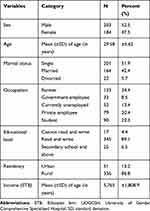 |
Table 1 Socio-Demographic Characteristics Visitors in UOGCSH, 2020 (N=387) |
Knowledge of Hospital Visitors Towards COVID-19
The overall prevalence of poor knowledge among hospital visitors towards COVID-19 was 44.2%, with 95% CI=39.3–49.1%. Among the total participants, 224 (57.9%) responded correctly to the main clinical symptoms of COVID-19. About half (189, 48.8%) of participants knew the elderly who had chronic illness and suppressed immunity were more likely infected with COVID-19. Among the total participants, more than half, 230 (59.4) knew that traveling to an infectious area or having contact with someone who had traveled to an area where the infection was present is a risk of developing an infection. About half (212, 54.8%) of the participants knew that people who have contact with someone infected with the COVID-19 virus should be immediately isolated in the proper place to prevent the spread of COVID-19 transmission (Table 2).
 |
Table 2 Knowledge of COVID-19 Among Visitors of UOGCSH, 2020 (N=387) |
Associated Factors of Visitors Knowledge Towards COVID-19
In multivariable logistic regression analysis, variables such as female sex, divorced marital status, and rural residency were significantly associated with poor knowledge about COVID-19. The odds of poor knowledge towards COVID-19 was 2.9-times more likely (AOR=2.79, 95% CI=1.752–4.44) in female than in male participants. Participants who were divorced (AOR=0.29, 95% CI=0.09–0.88) were 71% less likely to have poor knowledge than a single one. The odds of poor knowledge in rural residency were 1.67-times (AOR=1.93, 95% CI=1.07–3.26) more likely than urban residency (Table 3).
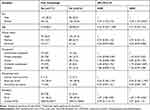 |
Table 3 Cross-Tabulation of Socio-Demographic Variables with Participants’ Knowledge About COVID-19 Among Visitors of UOGCSH, 2020 (N=387) |
Attitude of Hospital Visitors Towards COVID-19
The overall prevalence of negative attitude among hospital visitors towards COVID-19 was 41.6% with 95% CI=37–46.5%. One hundred and twenty-three (31.8%) participants assumed that they had low risk of infection with COVID-19 and 183 (47.3%) participants perceived they had very low protection from COVID-19. One hundred and fifty-one (39%) participants perceived that they could be infected easily with COVID-19. Among the total participants, 132 (34.1) supposed that they had difficulty in washing hands frequently for 20 seconds with soap or using sanitizer. Avoiding touching face with unwashed hands, shaking others, and attending in a crowded population were assumed easy for about 118 (30.5%), 122 (31.5%), and 155 (40.1%), respectively. Practicing physical distancing, covering the mouth or nose during cough or sneeze elbow/or tissue and avoid close contact with sick people were perceived as very easy by 147 (38%), 124 (32%), and 155 (40.1%), respectively (Table 4).
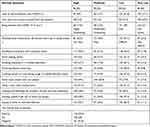 |
Table 4 Attitude of COVID-19 Among Visitors of UOGCSH, 2020 (N=387) |
Associated Factors of Visitors Attitude Towards COVID-19
In this study variable, factors like marital status, residency, and income were entered into multivariable logistic regression. In multivariable logistic analysis, only the level of income was statistically significantly associated with the negative attitude of participants towards COVID-19.
In this study a one ETB increase of the monthly income was associated with a 74% decrease (AOR=0.26, 95% CI=0.031–0.051) of having poor attitude (Table 5).
 |
Table 5 Cross-Tabulation of Socio-Demographic Variables with Participants’ Attitude About COVID-19 Among Visitors of UOGCSH, 2020 (N=387) |
Precautionary Measures of Hospital Visitors
The overall prevalence of poor precautionary measures among hospital visitors towards COVID-19 was 39%, with 95% CI=34.9–43.7%.
Among the total participants, the majority (228, 58%) of them participate or visit crowded places like church/mosque, market, bank, and others. In recent days, around 293 (75.7%) participants had worn a mask when leaving home, however about 207 (53.5%) and 245 (63.3) participants were touching the front of the mask when taking it off and reuse the mask for a long time, respectively. Among the total participants, 263 (68%) were well used precautionary measures of washing hands with soap and water frequently for at least 20 seconds or use sanitizer/60% sanitizer. The majority, 263 (68%) of the participants were touching their eyes, nose, and mouth frequently with unwashed hands. One hundred and sixty-three (42.1%) participants were practiced in cleaning and disinfecting frequently touched objects or surfaces. More than half (198, 51.2%; and 226, 58.4%) of the participants were applying the precautionary measures of physical distancing by 2 meters away at all times and eat or drink in bar and restaurant, respectively. Among the total participants, about 178 (46%) preferred not to stay at home during the transmission period. Less than half (164, 42.4%) of participants listened to and followed the direction of state local authorities (Table 6).
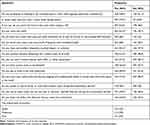 |
Table 6 Precautionary Measures of COVID-19 Among Participants’ of UOGCSH, 2020 (N=387) |
Associated Factors of Visitors Precautionary Measures Towards Prevention of COVID-19
In the multivariable logistic regression analysis, variables such as sex, occupation, residency, poor knowledge, and poor attitude were statistically significantly associated with poor precautionary measures towards COVID-19.
The odds of poor precautionary measures were 1.9-times (AOR=1.9, 95% CI=1.21–2.98) more likely in female participants than male participants. Participants who were currently unemployed were 4.13-times (AOR=4.13, 95% CI=1.60–10.63) more likely to have poor precautionary measures than government employees. The odds of poor precautionary measures were 2.62-times (AOR=2.62, 95% CI=1.08–6.33) higher in farmers than their counterparts. In rural residency participants, the odds of poor precautionary measures were 2.53-times (AOR=2.53, 95% CI=1.31–4.88) more likely than urban residence participants. The odds of poor precautionary measures were 2.38-times (AOR=2.38, 95% CI=1.52–3.72) higher in those having poor knowledge than their counterparts. Participants who had a negative attitude were 3.25-times (AOR=3.25, 95% CI=2.07–5.09) more likely to use poor precautionary measures than their counterparts (Table 7).
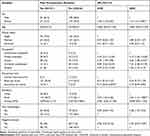 |
Table 7 Cross-Tabulation of Socio-Demographic Variables with Participants’ Precautionary Measures About COVID-19 Among Visitors of UOGCSH, 2020 (n=387) |
Discussion
This study assessed the knowledge, attitude, and precautionary measures of COVID-19 following the pandemic nature of the disease. Therefore, this study would inform public health education and commitment to mitigate the spread of COVID-19 virus.
The overall prevalence of poor knowledge towards COVID-19 among hospital visitors was 44.2%. This finding was higher than the studies done in Ethiopia,14,15,18 Kenya,20 Uganda,21,22 China,23 India,24 Italy,25 and Saudi Arabia.26 The finding was in line with the study done in the US.16 This might be due to the assessment tool used and studies data collection time. In studies done in China, India, Italy, and Saudi Arabia, data collection was done in the meantime of the outbreak in which most of the study population were aware of a lot of information about COVID-19. However, most of this study population were rural residents, who had no access towards COVID-19 related information due to the lack of mobile network and mass media.27,28 In addition, the majority of these study participants were farmers. This group of participants mostly illiterate and had difficulty to access information about COVID-19.29
The odds of poor knowledge towards COVID-19 was 2.9-times more likely in females than male participants. This finding was in line with the studies done in Ethiopia,14,18 Malaysia,30 Saudi Arabia,26,31 Paraguay,32 and the US.16 The possible explanation might be due to extraordinary activities of females as compared with males such as cooking, washing, and preparing for daily home consumption. Therefore, they might have less time to read and scale up their knowledge by far.33
Participants with divorced marital status (AOR=0.29, 95% CI=0.09–0.88) were 71% less likely to have poor knowledge than a single one. This finding was supported by the study done in Ethiopia.14 The possible explanation might be due to those divorced being less equipped, with better-shared information being available when married than being single.
The odds of poor knowledge in rural residency were 1.673-times more likely than urban residency. This result was in line with the studies done in Ethiopia,14,15 Kenya,34 Sub- Saharan,35 and China.36 This might be due to a lack of health information to an individual being accessed by the online technology to develop their knowledge and practice level. Such a group population could not access information due to the poor mobile network system and lack of mass media in the rural area.29 In addition, the rural population in Ethiopia were illiterate, making it too difficult to understand and access health information.37,38
The overall prevalence of negative attitude among hospital visitors towards COVID-19 was 41.6%. This finding was lower than the study conducted in Uganda.21,22 The possible explanation might be due to the majority of the participants in Uganda (54%), and were secondary level education which might have positive attitude towards COVID-19.
In this study a one-unit increase in ETB of the monthly income was associated with a 74% decrease (AOR=0.26, 95% CI=0.031–0.051) of having a poor attitude. This might be due to the economical level of an individual, can influence the behavioral aspect of the health status of an individual.39 This finding was also supported by pieces of evidence, which highlights low monthly income, and can influence once feeling towards behavioral aspects of an individual’s.40–42
The prevalence of poor precautionary measures among hospital visitors towards COVID-19 was 39%. This finding was lower than the study done in Ethiopia14 and higher than the study done in Uganda.21,22 The finding was also inconsistent with studies done in China23 and Iran.43 The possible reason might be due to the information and knowledge gap to apply recommended actions towards prevention of COVID-19. The health authority commitment towards tackling of COVID-19 might be another discrepancy in the result.
Participants who were currently unemployed had 4.13-times more poor precautionary measures than government employees. The odds of poor precautionary measures were 2.62-times in farmer participants than counterparts. This finding is consistent with the study done in Ethiopia.15,18 This possible justification might be due to the lack of different sources of information, frequency of media exposure, and the difference in behavior of an individual to apply the recommended prevention mechanism of COVID-19.
In rural residency participants, the odds of poor precautionary measures were 2.53-times more likely than urban residency. This finding is in line with studies in Ethiopia,14 Kenya,34 Sub-Saharan,35 and China.36 The possible justification might be due to the inadequate availability of basic needs, such as water, drainage, waste collection, and ventilated housing, which leads to poor performance to apply precautionary measures.44
Participates with poor precautionary measure were 2.38- and 3.25-times more likely to have poor knowledge and negative attitudes, respectively. This finding is in line with studies done in Ethiopia14 and China.23 This might be due to the fact that knowledge is the precondition to have good precautionary measures and a positive attitude towards COVID-19. Conveying equipped knowledge of COVID-19 can decrease the risk of infection by improving participants’ precautionary measures.45
This study had certain limitations. Use of consecutive sampling is one of the limitations of this study. The cross-sectional type of this study is also of the limitation of the study that cannot clearly identify cause and effect relationships between study variables.
Conclusion
The finding of this study showed that more than one-third of the participants had poor magnitude of knowledge, attitude, and precautionary measures towards COVID-19 disease.
Female sex, divorced marital status, and rural residency of the study population were significantly associated with poor knowledge, whereas female sex, farmer, rural residency, poor knowledge, and poor attitude were significantly associated with poor precautionary measures. Furthermore, low monthly income was significantly associated with a negative attitude of the study population.
An inclusive health education program concerning knowledge, attitude, and practice toward COVID-19 should be widened for especially those study populations coming from the rural population. The government and health authorities should aid public knowledge and understanding of COVID-19. Community engagement is also important to combat COVID-19 by addressing preventive methods. Specific health education also needed for some special groups, which had poor KAP level towards COVID-19 prevention strategies.
Abbreviations
AOR, adjusted odds ratio; COVID-19, novel coronavirus disease 2019; COR, crude odds ratio; KAP, knowledge, attitude, and precautionary measures; SARS 2-COV-2, severe acute respiratory syndrome coronavirus; WHO, World Health Organization; UOGCSH, University of Gondar Comprehensive Specialized Hospital.
Data and Material Availability
The raw data is available in online repositories as supplementary material (see supplementary file1: Table S1).
Ethical Approval and Consent of Participating
The study was performed based on the ethical standards put down in the Declaration of Helsinki. Ethical clearance was obtained from the institutional ethical review committee of the school of nursing and college of health science of University Gondar with ethical clearance letter reference number IRB 00109. The official permission letter was obtained from the University of Gondar hospital administration. After understanding the purpose of the study, written informed consent was obtained from study participants. Confidentiality of participants’ information was kept.
Acknowledgment
Our deepest gratitude goes to the University of Gondar for all expenses of this research work and study participants participated in this research. The authors also would like to give togreat appreciation to the data collectors (Misganew Tilahun, Ketemaw Tsegeye, and Jember Ayalew) and supervisor (Eneye Hussien) for their contribution to this paper.
Author Contributions
All authors made a significant contribution to the work reported, whether that is in the conception, study design, execution, acquisition of data, analysis and interpretation, or in all these areas; took part in drafting, revising, or critically reviewing the article; gave final approval of the version to be published; have agreed on the journal to which the article has been submitted; and agree to be accountable for all aspects of the work.
Funding
The study was supported by the University of Gondar College of medicine and health science. The funding had no further role in the design, data collection, analysis, drafting, manuscript, preparation and publication of this paper.
Disclosure
The authors declare that they have no competing interests.
References
1. Masters PS. Coronavirus genomic RNA packaging. Virology. 2019;537:198–207. doi:10.1016/j.virol.2019.08.031
2. Guan W-J, Ni Z-Y, Hu Y, et al. Clinical characteristics of coronavirus disease 2019 in China. N Engl J Med. 2020;382(18):1708–1720. doi:10.1056/NEJMoa2002032
3. Saitz R, Palfai TP, Cheng DM, et al. Screening and brief intervention for drug use in primary care: the ASPIRE randomized clinical trial. JAMA. 2014;312(5):502–513. doi:10.1001/jama.2014.7862
4. Organization WH. Modes of Transmission of Virus Causing COVID-19: Implications for IPC Precaution Recommendations: Scientific Brief, 27 March 2020. World Health Organization; 2020.
5. Team EE. Note from the editors: World Health Organization declares novel coronavirus (2019-nCoV) sixth public health emergency of international concern. Eurosurveillance. 2020;25(5):200131e.
6. Organization WH. Coronavirus disease (COVID-2019) situation reports. 2020.
7. Organization WH. Coronavirus disease ( COVID-19): weekly epidemiological update. 2020.
8. Burke RM. Active monitoring of persons exposed to patients with confirmed COVID-19—United States, January–February 2020. MMWR Morb Mortal Wkly Rep. 2020;69.
9. Zettler I, Schild C, Lilleholt L, Böhm R. Individual differences in accepting personal restrictions to fight the COVID-19 pandemic: results from a Danish adult sample. 2020.
10. Tadesse AW, Melese N, Eshetie S, Chane M, Ali A. Knowledge, attitude, and practice and associated factors towards COVID-19 among college students in Amhara Region, Ethiopia; a cross-sectional study. 2020.
11. Jemal B, Ferede ZA, Mola S, et al. Knowledge, attitude and practice of healthcare workers towards COVID-19 and its prevention in Ethiopia: a multicenter study. 2020.
12. Chen N, Zhou M, Dong X, et al. Epidemiological and clinical characteristics of 99 cases of 2019 novel coronavirus pneumonia in Wuhan, China: a descriptive study. Lancet. 2020;395(10223):507–513. doi:10.1016/S0140-6736(20)30211-7
13. Holshue ML, DeBolt C, Lindquist S, et al. First case of 2019 novel coronavirus in the United States. N Engl J Med. 2020;382(10):929–936. doi:10.1056/NEJMoa2001191
14. Akalu Y, Ayelign B, Molla MD. Knowledge, attitude and practice towards COVID-19 among chronic disease patients at Addis Zemen Hospital, Northwest Ethiopia. Infect Drug Resist. 2020;13:1949. doi:10.2147/IDR.S258736
15. Nigussie TF, Azmach NN. Knowledge, attitude and practice towards Covid-19 among Arba Minch Town, Southern Ethiopia. GSJ. 2020;8(6).
16. Alobuia WM, Dalva-Baird NP, Forrester JD, Bendavid E, Bhattacharya J, Kebebew E. Racial disparities in knowledge, attitudes and practices related to COVID-19 in the USA. J Public Health (Bangkok). 2020.
17. Cai H, Tu B, Ma J, et al. Psychological impact and coping strategies of frontline medical staff in hunan between january and march 2020 during the outbreak of Coronavirus disease 2019 (COVID-19) in Hubei, China. Med Sci Monit. 2020;26:e924171.
18. Kebede Y, Yitayih Y, Birhanu Z, Mekonen S, Ambelu A, Tu W-J. Knowledge, perceptions and preventive practices towards COVID-19 early in the outbreak among Jimma university medical center visitors, Southwest Ethiopia. PLoS One. 2020;15(5):e0233744. doi:10.1371/journal.pone.0233744
19. Kaliyaperumal K. Guideline for conducting a knowledge, attitude and practice (KAP) study. AECS Illumination. 2004;4(1):7–9.
20. Austrian K, Pinchoff J, Tidwell JB, et al. COVID-19 related knowledge, attitudes, practices and needs of households in informal settlements in Nairobi, Kenya. 2020.
21. Usman IM, Ssempijja F, Ssebuufu R, et al. Community drivers affecting adherence to WHO guidelines against covid-19 amongst rural Ugandan market vendors. Front Public Health. 2020;8:340. doi:10.3389/fpubh.2020.00340
22. Olum R, Kajjimu J, Kanyike AM, et al. Perspective of medical students on the COVID-19 pandemic: survey of nine medical schools in Uganda. JMIR Public Health Surveill. 2020;6(2):e19847. doi:10.2196/19847
23. Zhong B-L, Luo W, Li H-M, et al. Knowledge, attitudes, and practices towards COVID-19 among Chinese residents during the rapid rise period of the COVID-19 outbreak: a quick online cross-sectional survey. Int J Biol Sci. 2020;16(10):1745. doi:10.7150/ijbs.45221
24. Prasad Singh J, Sewda A, Shiv DG. Assessing the knowledge, attitude and practices of students regarding the COVID-19 pandemic. J Health Manag. 2020;22(2):281–290. doi:10.1177/0972063420935669
25. Taghrir MH, Borazjani R, Shiraly R. COVID-19 and Iranian medical students; a survey on their related-knowledge, preventive behaviors and risk perception. Arch Iran Med. 2020;23(4):249–254. doi:10.34172/aim.2020.06
26. Al-Hanawi MK, Angawi K, Alshareef N, et al. Knowledge, attitude and practice toward COVID-19 among the public in the Kingdom of Saudi Arabia: a cross-sectional study. Front Public Health. 2020;8. doi:10.3389/fpubh.2020.00217
27. Barnes DF, Golumbeanu R, Diaw I. Beyond Electricity Access: Output-Based Aid and Rural Electrification in Ethiopia. World Bank; 2016.
28. Bhagavathula AS, Aldhaleei WA, Rahmani J, Mahabadi MA, Bandari DK. Novel coronavirus (COVID-19) knowledge and perceptions: a survey on healthcare workers. MedRxiv. 2020.
29. Estacio EV, Whittle R, Protheroe J. The digital divide: examining socio-demographic factors associated with health literacy, access and use of internet to seek health information. J Health Psychol. 2019;24(12):1668–1675. doi:10.1177/1359105317695429
30. Azlan AA, Hamzah MR, Sern TJ, Ayub SH, Mohamad E, Tu W-J. Public knowledge, attitudes and practices towards COVID-19: a cross-sectional study in Malaysia. PLoS One. 2020;15(5):e0233668. doi:10.1371/journal.pone.0233668
31. Almofada SK, Alherbisch RJ, Almuhraj NA, et al. Knowledge, attitudes, and practices toward COVID-19 in a Saudi Arabian population: a cross-sectional study. Cureus. 2020;12(6).
32. Rios-González CM Knowledge, attitudes and practices towards COVID-19 in Paraguayans during outbreaks: a quick online survey.
33. Dessalegn M, Ayele M, Hailu Y, et al. Gender inequality and the sexual and reproductive health status of young and older women in the Afar Region of Ethiopia. Int J Environ Res Public Health. 2020;17(12):4592. doi:10.3390/ijerph17124592
34. Corburn J, Vlahov D, Mberu B, et al. Slum health: arresting COVID-19 and improving well-being in urban informal settlements. J Urban Health. 2020;1–10.
35. Wallace LJ, Nouvet E, Bortolussi R, et al. COVID-19 in sub-Saharan Africa: impacts on vulnerable populations and sustaining home-grown solutions. Can J Public Health. 2020;111(5):649–653. doi:10.17269/s41997-020-00399-y
36. Zhan S, Yang YY, Fu C. Public’s early response to the novel coronavirus–infected pneumonia. Emerg Microbes Infect. 2020;9(1):534. doi:10.1080/22221751.2020.1732232
37. Hironaka LK, Paasche-Orlow MK. The implications of health literacy on patient–provider communication. Arch Dis Child. 2008;93(5):428–432. doi:10.1136/adc.2007.131516
38. Wolf MS, Gazmararian JA, Baker DW. Health literacy and functional health status among older adults. Arch Intern Med. 2005;165(17):1946–1952. doi:10.1001/archinte.165.17.1946
39. Schulz MSM, Monestel-Umaña S, Schulz PJ. The relationship between health literacy and health disparities: a systematic review. PLoS One. 2015;10(12):e0145455. doi:10.1371/journal.pone.0145455
40. Park CL, Cho D, Moore PJ. How does education lead to healthier behaviours? Testing the mediational roles of perceived control, health literacy and social support. Psychol Health. 2018;33(11):1416–1429. doi:10.1080/08870446.2018.1510932
41. Vickers NJ. Animal communication: when i’m calling you, will you answer too? Curr Biol. 2017;27(14):R713–R5. doi:10.1016/j.cub.2017.05.064
42. Braveman PA, Cubbin C, Egerter S, Williams DR, Pamuk E. Socioeconomic disparities in health in the United States: what the patterns tell us. Am J Public Health. 2010;100(S1):S186–S96. doi:10.2105/AJPH.2009.166082
43. Erfani A, Shahriarirad R, Ranjbar K, Mirahmadizadeh A, Moghadami M. Knowledge, attitude and practice toward the novel coronavirus (COVID-19) outbreak: a population-based survey in Iran. Bull World Health Organ. 2020;30.
44. Organization WH. Progress on Household Drinking Water, Sanitation and Hygiene 2000–2017: Special Focus on Inequalities. World Health Organization; 2019.
45. McEachan R, Taylor N, Harrison R, Lawton R, Gardner P, Conner M. Meta-analysis of the reasoned action approach (RAA) to understanding health behaviors. Ann Behav Med. 2016;50(4):592–612. doi:10.1007/s12160-016-9798-4
 © 2020 The Author(s). This work is published and licensed by Dove Medical Press Limited. The full terms of this license are available at https://www.dovepress.com/terms.php and incorporate the Creative Commons Attribution - Non Commercial (unported, v3.0) License.
By accessing the work you hereby accept the Terms. Non-commercial uses of the work are permitted without any further permission from Dove Medical Press Limited, provided the work is properly attributed. For permission for commercial use of this work, please see paragraphs 4.2 and 5 of our Terms.
© 2020 The Author(s). This work is published and licensed by Dove Medical Press Limited. The full terms of this license are available at https://www.dovepress.com/terms.php and incorporate the Creative Commons Attribution - Non Commercial (unported, v3.0) License.
By accessing the work you hereby accept the Terms. Non-commercial uses of the work are permitted without any further permission from Dove Medical Press Limited, provided the work is properly attributed. For permission for commercial use of this work, please see paragraphs 4.2 and 5 of our Terms.
